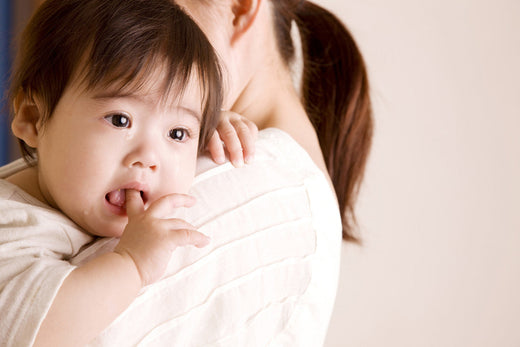
Crying is every baby’s way of communicating need. When your baby starts crying, the first thing you need to do is check if their basic needs have been met.
Is your baby hungry or thirsty?
Signs of hunger include: when babies open and close their mouth; when they bring their fists to their mouth or start to suck on their fists; when they become more alert and active; or when they seem to be looking for a source of feeding1.
Check their diaper in case it needs changing.
You may need to take it off and look to be certain.

Is your baby crying after feeding?
You need to burp your baby if they’re full. For new parents, make sure you know how to burp your baby the right way by looking up instructions or how-to videos.
Make sure they’re not chilly, or not too warm.
Ideal room temperature for babies is 18 degrees Celsius2. Keep their head uncovered and make sure they have a blanket to keep snug in the crib.
Make sure your baby’s not running a fever.
If need be, use a thermometer to be certain. Normal temperature for babies is around 36.4 degrees Celcius3.
If nothing seems amiss and yet your baby keeps crying, you can try the following advice on how to soothe a crying baby.
Swaddling
Swaddling is an age-old practice for a reason. It imitates your touch and makes your baby feel safe and cozy. Often, it can lull your baby to sleep.
Use a soft, breathable blanket for swaddling. It should feel snug, but not tight, around your baby.
Keep in mind that the blanket shouldn’t immobilize their entire body. Your baby’s legs should be able to rest in their natural or default position, also called “frog position,” inside the blanket. They should be free to move their hips and knees with enough room to kick4.
Take a look at our educational video on how to swaddle a baby on our members-only portal at the Enfamama A+ Club. Sign up today to access premium baby care content on swaddling, plus so much more.

Humming, Singing, and Playing Music
Music can influence emotion, so it’s no surprise that soft, soothing lullabies can help your baby relax.
You can try humming or singing to your baby to start with, using the familiar sound of your voice to bring a sense of comfort and security to your baby. Humming while holding them to your chest can also soothe them using the vibrations of your voice in your chest. You can gently pat or rub their back and rock them in your arms.
Once they’re pacified and if they seem ready to take a nice, long nap, you can put your baby to sleep by leaving relaxing music on in the background. You can play lullabies or calming instrumental music. This is especially useful for any baby crying at night. Leave the music on until they’re fast asleep.
Give Them a Massage
A gentle massage can soothe your baby. It’s also a great chance to bond with them through touch.
To begin, undress your baby and lay them on their back on a soft but firm surface. Calm them down by gently but firmly gliding your hands over their skin, from the neck and working your way down. Maintain skin contact at all times5. If your baby’s at least one month old, you can use oils and lotions with baby-friendly formulas6.
Go on a Drive
While going on a drive requires extra steps and time, it’s often worth the effort when you’re running out of ideas on how to soothe a crying baby.
A lot of babies get lulled to sleep in a moving car. Tuck them into their safety seat and go on a drive, choosing a scenic route if you can. The vibrations in the car as well as the white noise of the surroundings can help soothe your fussy baby. Even if it doesn’t lull them to sleep, the change in environment and the many sights passing by can be a welcome distraction and a convenient form of entertainment to your baby.
Seeking more handy baby care tips? Join the Enfamama A+ Club today to access premium members-only content on swaddling, essential items to buy for newborns, how to calm a crying baby and so much more. Sign up today for free access and free samples.
REFERENCES:
- Baby’s Hunger Cues - USDA,
https://wicbreastfeeding.fns.usda.gov/babys-hunger-cues
Accessed October 25, 2021 - Safe Sleep for Your Baby - NHS Sheffield,
https://www.sth.nhs.uk/clientfiles/File/Sleep%20Safe%20inners%20[web][1].pdf
Accessed October 25, 2021 - How to take your baby’s temperature - NHS UK,
https://www.nhs.uk/conditions/baby/health/how-to-take-your-babys-temperature
Accessed October 25, 2021 - Swaddling a baby: the benefits, risks and seven safety tips - First 1,000 Days,
https://www.nct.org.uk/baby-toddler/slings-and-swaddling/swaddling-baby-benefits-risks-and-seven-safety-tips
Accessed October 25, 2021 - How to massage your baby - Tresillian.org,
https://www.tresillian.org.au/advice-tips/bath-massage/massage/
Accessed October 25, 2021 - Soothing a crying baby - NHS UK,
https://www.nhs.uk/conditions/baby/caring-for-a-newborn/soothing-a-crying-baby
Accessed October 25, 2021



